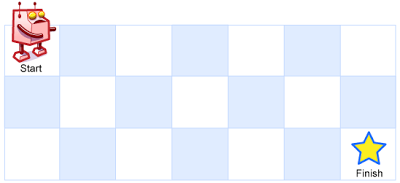LeetCode-in-All
62. Unique Paths
Medium
A robot is located at the top-left corner of a m x n grid (marked ‘Start’ in the diagram below).
The robot can only move either down or right at any point in time. The robot is trying to reach the bottom-right corner of the grid (marked ‘Finish’ in the diagram below).
How many possible unique paths are there?
Example 1:

Input: m = 3, n = 7
Output: 28
Example 2:
Input: m = 3, n = 2
Output: 3
Explanation:
From the top-left corner, there are a total of 3 ways to reach the bottom-right corner:
1. Right -> Down -> Down
2. Down -> Down -> Right
3. Down -> Right -> Down
Example 3:
Input: m = 7, n = 3
Output: 28
Example 4:
Input: m = 3, n = 3
Output: 6
Constraints:
1 <= m, n <= 100- It’s guaranteed that the answer will be less than or equal to
2 * 109.
To solve this task using Python with a Solution class, you can follow these steps:
- Define a class named
Solution. - Inside the class, define a method named
uniquePathsthat takesmandnas input parameters. - Implement the logic to calculate the number of unique paths using dynamic programming.
- Create a grid of size
m x nto store the number of unique paths to each cell. - Initialize the first row and first column of the grid to 1, as there is only one way to reach any cell in the first row or column.
- Iterate through the grid and calculate the number of unique paths to each cell using the formula
grid[i][j] = grid[i-1][j] + grid[i][j-1]. - Return the number of unique paths to the bottom-right corner of the grid (
grid[m-1][n-1]).
Here’s the implementation:
class Solution:
def uniquePaths(self, m: int, n: int) -> int:
# Create a grid to store the number of unique paths to each cell
grid = [ [0] * n for _ in range(m)]
# Initialize the first row and first column to 1
for i in range(m):
grid[i][0] = 1
for j in range(n):
grid[0][j] = 1
# Calculate the number of unique paths to each cell
for i in range(1, m):
for j in range(1, n):
grid[i][j] = grid[i-1][j] + grid[i][j-1]
# Return the number of unique paths to the bottom-right corner
return grid[m-1][n-1]
# Example usage:
solution = Solution()
print(solution.uniquePaths(3, 7)) # Output: 28
print(solution.uniquePaths(3, 2)) # Output: 3
print(solution.uniquePaths(7, 3)) # Output: 28
print(solution.uniquePaths(3, 3)) # Output: 6
This implementation uses dynamic programming to efficiently calculate the number of unique paths. It iterates through the grid only once, so the time complexity is O(m * n), where m is the number of rows and n is the number of columns.
Solution
class Solution:
def uniquePaths(self, m: int, n: int) -> int:
dp = [[0] * n for _ in range(m)]
for i in range(m):
dp[i][0] = 1
for j in range(n):
dp[0][j] = 1
for i in range(1, m):
for j in range(1, n):
dp[i][j] = dp[i - 1][j] + dp[i][j - 1]
return dp[m - 1][n - 1]

